“Go (Chinese: åœæ£‹ wéiqÃ, Japanese: å›²ç¢ igo, [nb 2] Korean: 바둑 baduk, Vietnamese: cá» vây, common meaning: “encircling game”) is a board game for two players that originated in China more than 2,500 years ago.” — From the Wikipedia Article
I love this game. It keeps me humble. No other game teaches so much so simply. Go is about influence. But sometimes, it is about tactics. I recently lost a game. I made not 1, but 3 mistakes, that cost me the game. If I had not made any one of these three I would have won, and quite soundly. Instead, I lost by 1.5 points, a very close game.
Arrogance
Here is the state of the board before my first mistake. The plus sign indicates the last move made.
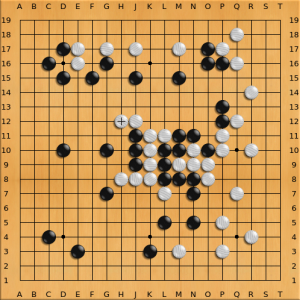 My opponent and I are battling for the middle of the board. I thought the stone at G 10 was enough to keep the group of three stones to its right alive. So I got arrogant. The very fact that he continued to attack should have been a warning. Here is mistake number 1. I played K12 and:
My opponent and I are battling for the middle of the board. I thought the stone at G 10 was enough to keep the group of three stones to its right alive. So I got arrogant. The very fact that he continued to attack should have been a warning. Here is mistake number 1. I played K12 and:
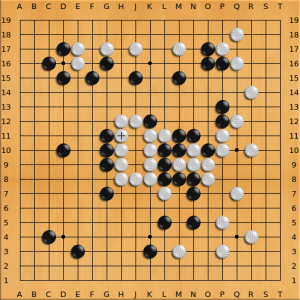 He controls the middle of the board, and it almost guaranteed life on this group. I made that at least something he had to work for.
He controls the middle of the board, and it almost guaranteed life on this group. I made that at least something he had to work for.
Here is mistake 1 corrected:
The connection made with the additional stone is called a “Bamboo Joint” and would have kept the group of 3 alive. Since he did not have much room for eye space around his group in the center, I could have kept pressure on it that large, floating group center on the K line, and used that to build a lot of territory for myself.
Takeaway Lesson: At least analyze thoroughly where he attacks. This is vulnerable to a classic tesuji, and I should have been aware of it. Groups of three are usually vulnerable in the center stone, and just a one point jump is not enough to connect them out.
Fear
Here is the state before the second mistake
 He has made a weak invasion into my space on the left side. His two groups are disconnected. I am a little afraid of him killing my L shaped group at B10, but counting the liberties on this group versus those on his groups, you can see I am up by one on the group at D9. If I kill that group, I don’t have to worry about his group above me, there is just not enough room for it to live. It is too far from the corner. The rule on the edge is Six Die but Eight Live. He has 3, and needs 5 more stones to live. No Way. Here’s my mistake:
He has made a weak invasion into my space on the left side. His two groups are disconnected. I am a little afraid of him killing my L shaped group at B10, but counting the liberties on this group versus those on his groups, you can see I am up by one on the group at D9. If I kill that group, I don’t have to worry about his group above me, there is just not enough room for it to live. It is too far from the corner. The rule on the edge is Six Die but Eight Live. He has 3, and needs 5 more stones to live. No Way. Here’s my mistake:
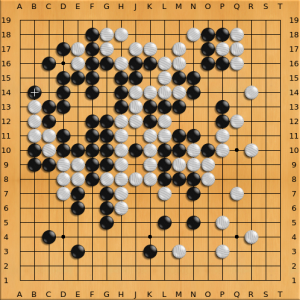 Yes, I end up killing the group on the second line. I was capable of doing that. But now I am in a capturing race with the group at D8, and, while I live, so does he.
Yes, I end up killing the group on the second line. I was capable of doing that. But now I am in a capturing race with the group at D8, and, while I live, so does he.
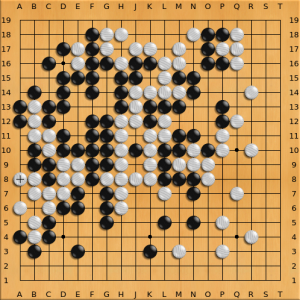 I can’t stop him from getting two eyes, and this group is alive.
I can’t stop him from getting two eyes, and this group is alive.
What I should have done:
This would have kept the pressure on that group. With 2 liberties and no where to run, I could have easily killed it. The best he could hope for would be to keep it in a state for a Ko threat like this.
Takeaway lessons: Don’t let unreasonable fear drive your decisions. I convinced myself he was stronger than he was, and counting liberties and remember the rules of thumb about life should have made that clear. Fear leads to suffering.
Resignation
Here is the state of the board before the third mistake.
I was convinced I had lost. I was closing out liberties, and hoping maybe to start a Ko fight to try and get some benefit off that group from mistake 2. As Murphy pointed out When both sides are convinced they are about to lose, they’re both right.  As it turns out, I could have won this one, and quite soundly. Here’s the mistake.
 The group on the lower right, starting at L1 is not necessarily connected to The rest of the corner. It was killable, but I didn’t see it, even though right before I was attacking this very group. He didn’t see it either, and played on a different part of the board. A couple moves later, he saw it and corrected his mistake.
The group on the lower right, starting at L1 is not necessarily connected to The rest of the corner. It was killable, but I didn’t see it, even though right before I was attacking this very group. He didn’t see it either, and played on a different part of the board. A couple moves later, he saw it and corrected his mistake.
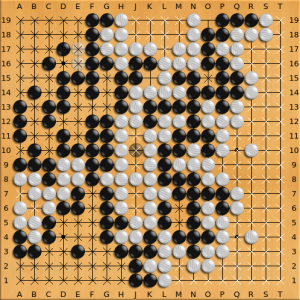 The connection at O2 happened and we scored the game a couple moves later. He won 88.5 to 87.
The connection at O2 happened and we scored the game a couple moves later. He won 88.5 to 87.
<A href=”http://en.wikipedia.org/wiki/Maud_Muller”>”For all sad words of tongue or pen, the saddest are these, it might have been” — John Greenleaf Whittier
Killing that group required a technique called a snapback. Here is the corrected move.
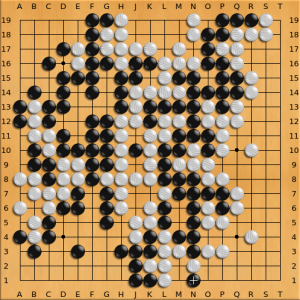 To connect from That group to the Group at O3 requires two moves. If he connects at O2:
To connect from That group to the Group at O3 requires two moves. If he connects at O2:
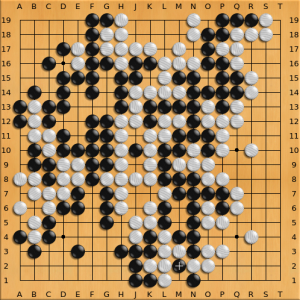 The throw in stone at M2 is a sacrifice. He captures it, but in doing so, also removes a liberty.  An additional stone at M2 and:
The throw in stone at M2 is a sacrifice. He captures it, but in doing so, also removes a liberty.  An additional stone at M2 and:
Now Black wins 99 to 85.5.
Takeaway lesson: In the end game, any group that is not solidly connected is a potential weakness. Analyze the cutting points. The snapback is a common enough move that it should be considered where ever you are close to killing, but might not quite be ahead in the capture in races. Don’t never give up.


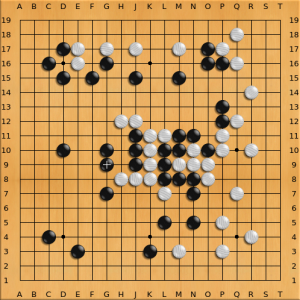



These rules/hints are really not limited to ‘Go’.
Nope. Go is just wonderful in that it makes them so clear.
You have a mistake in the last case/ Correct move is at M1.
Nice post, Go is a great game.
The opportunity was at M1. W would responded O1 to N1.
Thanks guys, appreciate the correction. I see that now. And that is how we learn. Such complexity in even the simplest of scenarios
This is the SGF of the whole game.
http://www.dragongoserver.net/sgf.php?gid=767715
Cool to see more Fedora Go players. You’re on DGS? I’m on there, but mostly Kaya these days.